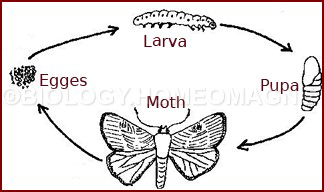Zoology related pages:
- Zoology
- Animal Kingdom Classification
- Beginning of Life
- Apiculture
- Fishery
- Capture Fisheries
- Culture Fishery
- Fish breeding
- Induced Breeding
- Composite Fish Culture
- Carp Disease
- Prawn Culture
- Brackish-Water Prawn Culture
- Sericulture
- Silkworm Diseases
- Mulberry Tree
- Cultured Pearls
- Poultry Farming
- Poultry Feed
- Rat Problem
- Rat Control
- Medical Zoology
- Life Cycle of Mosquito
- Roundworm
- Tapeworm
- Stem Borer
- Rice Bugs
- Protozoa
- Porifera
- Cindaria
Insect Pests of Paddy
Those insects that are damaging the paddy plant from its seedling stage to crop production stage are known as insect pests of paddy. Insect pests are classified into two groups, such as major pests and minor pests. Of the various major pests, the stem borer insect is the most dangerous enemy to the paddy plant.
What is Stem Borer?
Stem borer (Scirpophaga) is a serious paddy pest in India, Pakistan, Burma, Sri Lanka, China, Japan Formosa, Philippines and Indonesia. So, in all the rice growing areas this insect or Moth pest is available. This moth causes the highest percentage of damage of the paddy plant. The larva of this moth feeds only the internal tissue that the adult stage of this insect (moth) never causes any damage to the plant but only the larval stage. This pest is commonly known in English as stem borer because the larva bores into the stem.
LIFE CYCLE OF STEM BORER
In the life cycle of stem borer there are four stages, namely egg, larva, pupa and adult.
i) Oviposition and egg: After sunset, the male and female moths come together and after sexual union the eggs are fertilized internally, i.e., internal fertilization takes place. After three days of sexual union, the female moths lay eggs early at night on the upper surface near the tip of the growing leaves of paddy plant. Each female moth lays 400 - 600 eggs in 2 -3 egg clusters.
iii) Pupation: The full grown larvae make a thin silken case over themselves inside the stem and thus cocoons are formed. The white silken cocoon remains closed at the upper end by an operculum, the lower end being rounded and bag-like. Pupae never take any food. Pupa becomes dark brown. The pupa period is usually 6 to 10 days. It may be prolonged to a month depending on the climate.
iv) Adult: The adult moth comes out through the hole which is being made in the stem during the pre-pupation period. The moths are inactive during the day but are active in the evening. They have strong flight power. The stem borer moths are short -lived and die two to three days after laying eggs.
DAMAGING STAGE OF STEM BORER
The larval stage is the damaging stage of the stem borer, because this is the feeding stage, as they feed the internal tissues of the stem of the paddy. The adult moths are not doing any harmful effect to the paddy plant.
NATURE OF DAMAGE OF STEM BORER
Due to the utilization of the inner tissues of the stem of young paddy plant by the larvae of the stem borer, the central shoot of the paddy plant fades and dries up. The larvae then abandon the damaged plant and search for a new one. In older paddy plants, the larvae utilize the inner tissues of the stem and causes white, empty ear heads.
Control of Stem Borer
To control the stem borer the fallowing measure may be taken:
Mechanical control
Yellowish egg mass of the stem borer can be seen on the leaf of the paddy plant. These egg masses are to be collected from the field and destroyed them.
Destruction of stubbles
Larvae of Stem borer may remain inside the stubbles of the paddy plant. So after harvesting, the stubbles of the paddy plant should be uprooted and burnt. Thus the percentage of damage in the next crop may be reduced.
Light trapping
The stem borer moths are attracted to light during night. For this reason, the light traps are used extensively m the paddy field to attract and kill the pest.
Biological control
Biological control of stem borer generally refers to the use of predators or parasites of a past to reduce its numbers to a point where it is no longer an economical problem but it is yet to be discovered.
Chemical Control
The chemical control means the control of the stem borer by the use of some chemical insecticides. Before transplanting the seedlings of young paddy plants are to be immersed in 0.1% DDT solution may protect the plants from the attack of stem borer. After transplantation some insecticides like parathion, endrin may be used to protect from the attack of such insects.


